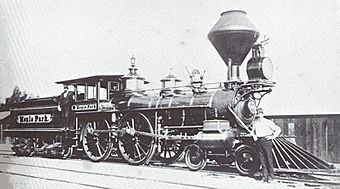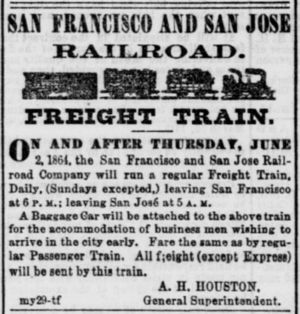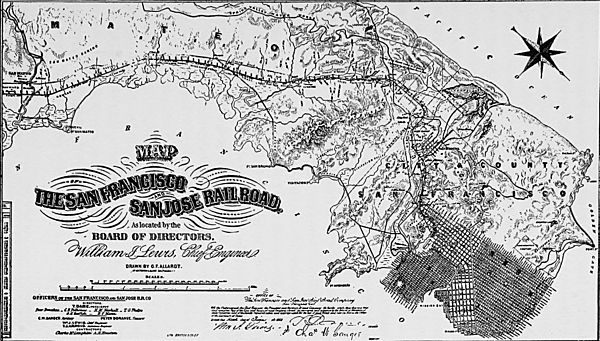San Francisco and San Jose Railroad facts for kids

Locomotive #11 of the SF&SJ.
|
|
| Overview | |
|---|---|
| Headquarters | San Francisco, California |
| Locale | San Francisco Peninsula Santa Clara Valley |
| Dates of operation | 1863–1870 |
| Successor | Southern Pacific; Caltrain |
| Technical | |
| Track gauge | 4 ft 8 1⁄2 in (1,435 mm) standard gauge |
The San Francisco and San Jose Railroad (SF&SJ) was an important railway in California. It connected the cities of San Francisco and San Jose, California. The tracks ran all the way down the San Francisco Peninsula.
The company started in 1860. It was one of the first railroads to hire Chinese workers to help build the tracks. The first part of the railway opened in 1863. The full 49.5-mile (80 km) route was finished in 1864. In 1870, the company joined with the Southern Pacific Railroad. Today, Caltrain and the Union Pacific Railroad still use parts of the original route.
Contents
History of the Railroad
People started thinking about a railroad between San Francisco and San Jose way back in 1849. A company called The Pacific and Atlantic Railroad Company (P&A) was formed in 1851. They planned the route, but they could not find enough money to build it. Banks in New York and England would not help without local money first.
The company tried again in 1853, but the economy was bad. No one wanted to invest.
Starting a New Company
In 1857, people became interested in building the railroad again. A new San Francisco and San Jose Railroad Company was created in 1859. They wanted the counties to buy shares in the company. But this idea was not popular, and the company closed in June 1860.
A brand new SF&SJ company started on August 18, 1860. Three important people helped make it happen:
- Peter Donahue, a businessman from San Francisco.
- Judge Timothy Dame, who became the president.
- Henry Newhall, a successful auctioneer.
These three are known as the founders of the railway line.
Building the Tracks
The builders, Houston & McLaughlin, agreed to build the line for $2 million. This payment included cash, bonds, and company shares. The SF&SJ company raised $2 million in shares in 1861. The City of San Francisco, San Mateo County, and Santa Clara County bought a lot of these shares.
Building the railroad cost about $40,000 for each mile of track. This was a normal price for railroads at that time. Because of the Civil War, it was hard to get materials like iron. Peter Donahue, Henry Newhall, and Charles B. Polhemus used their own connections to get what was needed.
The SF&SJ Railroad was one of the first to hire Chinese workers. They were paid less than other workers. Hiring Chinese workers was not a big issue at that time. This helped keep building costs down.
Construction began on July 15, 1861. The first part of the line opened for special trips on October 17, 1863. This trip went between San Francisco and Menlo Park.
The first train left Mission Station around 10:30 AM. It had six passenger cars and two locomotives. About 400 people were on board, including the Governors of California and Oregon. They went to Mayfield, then returned to Menlo Park for a picnic. This happened before the first rail of the big Pacific Railroad was even laid!
A few months later, the line to San Jose was finished on January 16, 1864. The first train to San Jose left at 9:55 AM. It arrived in Santa Clara almost three hours later. The trains were met with a thirteen-gun salute in San Jose. After speeches, a big barbecue was held.
The railroad made travel much faster. A trip that used to take eight hours by steamboat and stagecoach now took only three and a half hours. By February 1864, the SF&SJ offered four trains a day. Each trip was scheduled to take two hours and twenty minutes.
The railroad also made it easier and cheaper to move goods to market. By June 1864, a regular freight train was added. This helped farming become a major new industry in California.
Southern Pacific Takes Over
The Southern Pacific Railroad (SP) bought the SF&SJ company in March 1868. The Southern Pacific and Central Pacific companies then joined together on October 12, 1870. This was almost seven years after the first trains ran.
In the early 1900s, Southern Pacific improved the line. They added a second track. They also built new routes and shortcuts. One was the Dumbarton Cutoff, which was the first bridge across San Francisco Bay. Another was the Bayshore Cutoff. This moved the line closer to the San Francisco Bay shoreline.
Today, the BART train in San Mateo County uses the old SF&SJ route.
Caltrain Today
In 1977, Southern Pacific wanted to stop the Peninsula Commute train service. So, the State of California took over paying for it in July 1980.
In 1991, Southern Pacific sold the entire route to the Peninsula Corridor Joint Powers Board. This group now runs the commuter rail service called Caltrain. The Union Pacific Railroad still uses the line for moving freight (goods).
The Railroad Route
The SF&SJ line was built with a standard width between the rails. This was to make sure it could connect with other major railroads. They used redwood ties and strong rails.
The line had only one track. There were no tunnels and only a few bridges. The longest bridge was 240-foot (73 m) long over Islais Creek. The deepest cut into the land was only 35 feet (11 m) deep.
Trains and Engines
When the SF&SJ started special trips in October 1863, they had three locomotives. They also had six passenger cars and about twenty freight cars. Each engine cost $15,000. It could pull six passenger cars. Each passenger car cost $3,500 and could hold sixty people. Freight cars cost about $1,200 each.
The first three locomotives were named San Francisco, San José, and T. Dame. Most of the SF&SJ locomotives were the "American 4-4-0" type. This was a common type of train engine back then.
The San Francisco and San José engines were built in 1862 in Philadelphia. The third engine was built in Massachusetts. More engines were bought from different companies in New Jersey and other states.
The first full-sized steam locomotive made in California was built for the SF&SJ. It was named the California. Its first trip was on August 30, 1865. It set a speed record of 67 miles per hour (108 km/h)!
Images for kids







